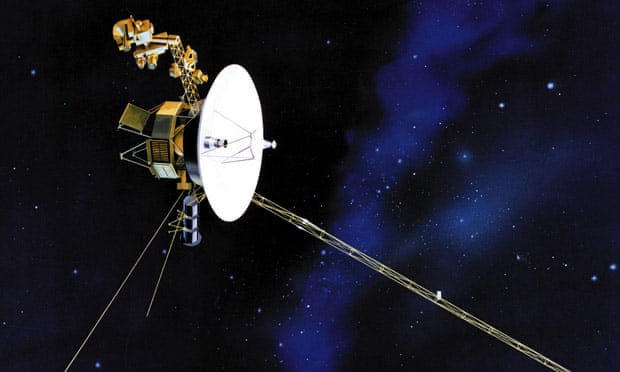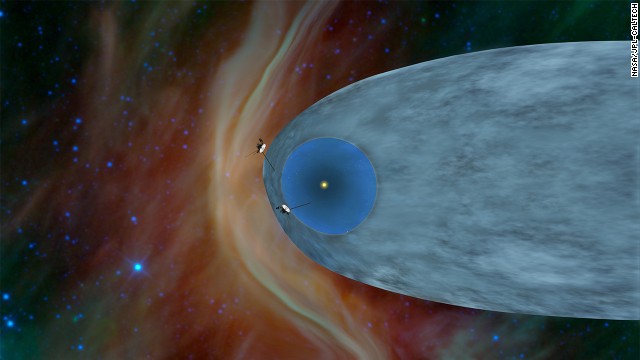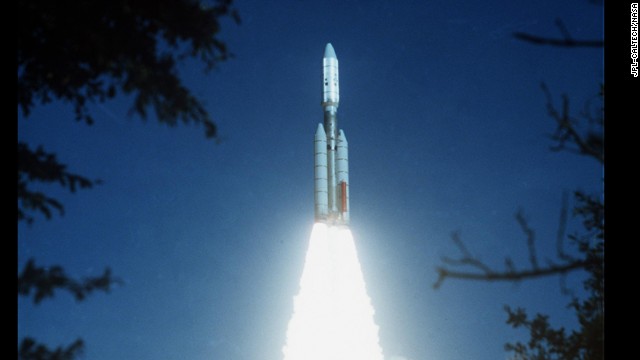SATELLITES TO THE STARS
Job 38:32 Living Bible
"Can you ensure the proper sequence of the seasons,or guide the constellation of the bear with SATELLITES across the heavens.
Spacecraft launched in 1977 to explore Jupiter and Saturn on the verge of entering new frontier in the Milky Way

Thirty-five years after leaving Earth, Voyager 1 is reaching for the stars.
Sooner or later, the workhorse spacecraft will bid adieu to the solar system and enter a new realm of space – the first time a man-made object will have escaped to the other side.
Perhaps no one on Earth will relish the moment more than 76-year-old Ed Stone, who has toiled on the project from the start.
"We're anxious to get outside and find what's out there," he said.
When Nasa's Voyager 1 and Voyager 2 first rocketed out of Earth's grip in 1977, no one knew how long they would live. Now, they are the longest-operating spacecraft in history and the most distant, at billions of miles from Earth but in different directions.
Wednesday marks the 35th anniversary of Voyager 1's launch to Jupiter and Saturn. It is now flitting around the fringes of the solar system, which is enveloped in a giant plasma bubble. This hot and turbulent area is created by a stream of charged particles from the sun.
Outside the bubble is a new frontier in the Milky Way – the space between stars. Once it plows through, scientists expect a calmer environment by comparison.
When that would happen is anyone's guess. Voyager 1 is in uncharted celestial territory. One thing is clear: the boundary that separates the solar system and interstellar space is near, but it could take days, months or years to cross that milestone.
Voyager 1 is currently more than 11bn miles from the sun. Twin Voyager 2, which celebrated its launch anniversary two weeks ago, trails behind at 9bn miles from the sun.
They're still ticking despite being relics of the early space age.
Each only has 68 kilobytes of computer memory. To put that in perspective, the smallest iPod – an 8-gigabyte iPod Nano – is 100,000 times more powerful. Each also has an eight-track tape recorder. Today's spacecraft use digital memory.
The Voyagers' original goal was to tour Jupiter and Saturn, and they sent back postcards of Jupiter's big red spot and Saturn's glittery rings. They also beamed home a torrent of discoveries: erupting volcanoes on the Jupiter moon Io; hints of an ocean below the icy surface of Europa, another Jupiter moon; signs of methane rain on the Saturn moon Titan.
Voyager 2 then journeyed to Uranus and Neptune. It remains the only spacecraft to fly by these two outer planets. Voyager 1 used Saturn as a gravitational slingshot to catapult itself toward the edge of the solar system.
"Time after time, Voyager revealed unexpected – kind of counterintuitive – results, which means we have a lot to learn," said Stone, Voyager's chief scientist and a professor of physics at the California Institute of Technology.
These days, a handful of engineers diligently listen for the Voyagers from a satellite campus not far from the Nasa Jet Propulsion Laboratory, which built the spacecraft.
The control room, with its cubicles and carpeting, could be mistaken for an insurance office if not for a blue sign overhead that reads "Mission Controller" and a warning on a computer: "Voyager mission critical hardware. Please do not touch!"
There are no full-time scientists left on the mission, but 20 part-timers analyse the data streamed back. Since the spacecraft are so far out, it takes 17 hours for a radio signal from Voyager 1 to travel to Earth. For Voyager 2, it takes about 13 hours.
Cameras aboard the Voyagers were turned off long ago. The nuclear-powered spacecraft, about the size of a small car, still have five instruments to study magnetic fields, cosmic rays and charged particles from the sun known as solar wind. They also carry gold-plated discs containing multilingual greetings, music and pictures – on the off-chance that intelligent species come across them.
Since 2004, Voyager 1 has been exploring a region in the bubble at the solar system's edge where the solar wind dramatically slows and heats up. Over the last several months, scientists have seen changes that suggest Voyager 1 is on the verge of crossing over.
When it does, it will be the first spacecraft to explore between the stars. Spaceobservatories such as the Hubble and Spitzer space telescopes have long peered past the solar system, but they tend to focus on far-away galaxies.
As ambitious as the Voyager mission is, it was scaled down from a plan to send a quartet of spacecraft to Jupiter, Uranus, Neptune and Pluto in what was billed as the "grand tour" of the solar system. But the plan was dropped, and scientists settled for the Voyager mission.
Howard McCurdy, a space policy expert at the American University in Washington, said it turned out to be a boon.
They "took the funds and built spacecraft robust enough to visit all four gas giants and keep communicating" beyond the solar system, he said.
The double missions so far have cost $983m (£620m) in 1977 dollars, which translates to $3.7bn now. The spacecraft have enough fuel to last until around 2020.
By that time, scientists hope Voyager will already be floating between the stars.
A new study in the journal Science suggests that the probe entered the interstellar medium around August 25, 2012. You may have heard other reports that Voyager 1 has made the historic crossing before, but Thursday was the first time NASA announced it.
The twin spacecraft Voyager 1 and 2 were launched in 1977, 16 days apart. As of Thursday, according to NASA's real-time odometer, Voyager 1 is 18.8 billion kilometers (11.7 billion miles) from Earth. Its sibling, Voyager 2, is 15.3 billion (9.5 billion) kilometers from our planet.

NASA: Voyager 1 has left solar system 02:07
PLAY VIDEO

EXPAND GALLERY
Voyager 1 is being hailed as the first probe to leave the solar system. But under a stricter definition of "solar system," which includes the distant comets that orbit the sun, we'd have to wait another 30,000 years for it to get that far, Stone said.
Another milestone for long after we're gone: The probe will fly near a star in about 40,000 years, Stone said.
How do we know?
Voyager, currently traveling at more than 38,000 miles per hour, never sent a postcard saying "Greetings from interstellar space!" So whether it has made the historic crossing or not is a matter of controversy.
"The spacecraft itself really doesn't know," Stone said. "It's only instruments that can tell us whether we're inside or outside."
Further complicating matters, the device aboard Voyager 1 that measures plasma -- a state of matter with charged particles -- broke in 1980.
To get around that, scientists detected waves in the plasma around the spacecraft and used that information to calculate density. Vibrations in the plasma came from a large coronal mass ejection from the sun in 2012, resulting in what Stone called a "solar wind tsunami." These vibrations reached the area around Voyager this spring.
Measurements taken between April 9 and May 22 of this year show that Voyager 1 was, at that time, located in an area with an electron density of about 0.08 per cubic centimeter.
In the interstellar medium, the density of electrons is thought to be between 0.05 and 0.22 per cubic centimeter. The particles of interstellar plasma were created by the explosions of giant stars, and carry the magnetic field of the galaxy, scientists said.
This illustration shows NASA's Voyager 1 spacecraft entering the space between stars.
Last year, between October 23 and November 27, researchers calculate that Voyager 1 was in an area with an electron density of 0.06 per cubic centimeter. That's still within the interstellar space range, and it means that over time the spacecraft passed through plasma with increasing electron density.
The study, led by University of Iowa physicist Donald Gurnett, suggests that the plasma density is about 30 times higher in the interstellar medium than in the heliosphere, which is close to what scientists thought based on other kinds of measurements. The boundary is called the heliopause.
Voyager mission timeline:
When did it happen?
Scientists have been using several kinds of measurements to figure out if and when Voyager 1 had reached the interstellar medium.
Evidence from particle data had already pointed toward the conclusion that the probe succeeded. In late July and early August of 2012, scientists saw dips in the concentration of particles made in the solar system, and peaks in particles made outside.
"If you just looked at that data, you'd think it's pretty clear that we've actually crossed a boundary. We're no longer in the place where the solar system particles are being made, and we're actually out in the interstellar medium," said Marc Swisdak, associate research scientist in the Institute for Research in Electronics and Applied Physics at the University of Maryland. Swisdak was not involved in the new study, but has worked with Voyager data.
Magnetic field measurements suggested otherwise. Researchers had expected to see stark changes in magnetic field direction when the probe crossed out of the heliosphere, but that wasn't supported by measurements from the probe.
Swisdak and colleagues published a modeling study suggesting that the particle data is more relevant, and that the magnetic field might not change as much as people thought. They proposed a crossing-over date of July 27 -- about a month sooner than the new study.
The specific date will likely be debated for some time, Swisdak said. One possible explanation is that if the heliosphere is analogous to an air-conditioned room, Voyager stepped through the doorway into a hot room on July 27. For a month it was in a metaphorical room with a mixture of hot and cold air, and finally entered the truly hot part on August 25.
Puzzles still surround the magnetic field at the edge of the heliosphere, Stone said, and "We're going to be prepared to have more surprises."
NASA sends unmanned rocket to the moon
What else is out there?
Voyager 1 has only 68 KB of memory on board -- far less than a smartphone, said Suzanne Dodd, Voyager project manager. Scientists communicate with the spacecraft every day.
"It's the little spacecraft that could," she said in a NASA press conference.
The probe now has a totally new mission, Stone said.
"We're now on the first mission to explore interstellar space," he said. "We will now look and learn in detail how the wind which is outside, that came from these other stars, is deflected around the heliosphere."
Wind -- made of particles -- from these other stars has to go around the heliosphere the way a water in a stream flows around a rock, Stone said. Scientists are interested in learning more about the interaction between our solar wind and wind from other stars.
Natural radioactive decay provides heat that generates enough electricity to help Voyager 1 communicate with Earth. The first science instrument will be turned off in 2020, and the last one will be shut down in 2025, Stone said.
Both Voyager probes carry time capsules known as "the golden record," a 12-inch, gold-plated copper disc with images and sounds so that extraterrestrials could learn about us. Let's hope they can build appropriate record players.
Voyager 2 will likely leave the heliosphere in about three to four years, Stone said.
Its plasma instrument is still working, Stone said, so scientists can directly measure the stellar wind's density, speed and temperature. That also means that when it crosses out of the heliosphere, Voyager 2 will send a clearer signal.
At that time, it will join its twin in the vast nothingness between stars that used to be beyond our reach.


Comments
Post a Comment